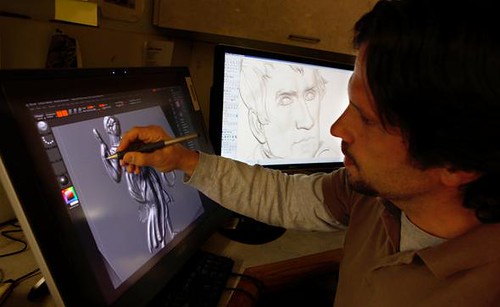
PREV ARTICLE
NEXT ARTICLE
FULL ISSUE
PREV FULL ISSUE
Dick Johnson submitted this entry from his Encyclopedia of Coin and Medal Terminology. Thanks. -Editor  Hired in 2005, Joseph Menna was the first artist employed by the U.S. Mint as a computer specialist for its engraving staff. Computer Engraving. Creating an image in varying depths digitally on a computer which establishes the controls for the milling of these depths in a die or hub. While computer engraving is a new tool in the hands of the coin and medal engraver the computer will not design a coin or medal. But like a burin in the hand of the engraver, it will aid the engraver to enter the design in MODULATED RELIEF by determining the amount of depth each point should cut into the die or matrix. Mints and medalmakers around the world were eager to accept the new technology, the most recent step in replacing the tedious act of hand engraving dies, as old as coins themselves. The advantages of computer engraving is not only "fast and cheap" but also its versatility to alter a design, to modify it, to test a new concept, to hone the relief to a satisfactory image. As such it is ideal for quickly developing a design in contrast to previous "clay and plaster" technology. Computer engraving language. Like any specialized methodology, engraving by computers has its own terminology. While sculptors create three dimensional relief design by carving and modeling computer engravers design with X, Y, and Z coordinates. The term for computer relief, as well as this class of engraved dies, is called "3D" for the rise and fall of the modulated design in three dimensions. New terms describe similar previous methods. What the hand engraver or modeler called PROVING the computer artist, for example, calls digital elevation model (DEM). Here are the most used digital terms. Computer Engraving Terms 2D – Two dimension, FLAT ENGRAVING Computer engraving technique.The computer engraver starts with a scan of a flat drawing, a CARTOON, or creates this on the screen. At each point on the two-dimensional design, called a pixel, X and Y coordinates are determined by the computer. The operator chooses the depth at this point, the Z coordinate. This fixes the sculptural or dimensional effect, the depth of the relief – to form the height in the die – the depth of the Z coordinate. An individual move to lower this point is called a "hammer blow." All three coordinates for that point are stored in the software, forming a bitmap. A visual image is shown on the screen of the CPR at all times. The operator moves through the design creating the modulated relief using a special tool, a touch-probe digitizer. A rapid phototype (RP) image can be obtained at any time. The finished and approved design fixed in the software will then be transferred to a milling machine which does the cutting as controlled by the digital file. Afterwards, burrs and rough corners from the milling tool must be worked as with any other TOUCHUP of dies. Status. Not all sculptor modellers have embraced the new computer engraving technology. Perhaps like the reaction of hand engravers to machine engravers when these were introduced in previous years, it took time to prove a new technology. Critics of computer engraving cite three shortcomings: micro modelling with the computer, portrait realism, and crispness of detail. Modellers in clay or wax can apply larger areas of a design at one time, while computer modelling is limited to a single point. Critics say computer generated portraits are stiff, frozen and lifeless. They would still prefer sculptors working in clay or wax to vivify a portrait making it more realistic and lifelike. In art vivify means "give life to." Since most viewers prefer highly detailed designs with sharp edge relief, this can be obtained in both old and new methods, However it requires repeated cutting a second or third time with finer cutting points in the milling operation, somewhat more difficult with the new method. Both technologies, however, have their place in the field and will continue to be employed in the minting industry. But most important it can be said: just as the old
technology did not replace the artist, neither will the new. Looking for the meaning of a numismatic word, or the description of a term? Try the Newman Numismatic Portal's Numismatic Dictionary at: https://nnp.wustl.edu/library/dictionaryOr if you would like a printed copy of the complete Encyclopedia, it is available. There are 1,854 terms, on 678 pages, in The Encyclopedia of Coin and Medal Technology. Even running two a week would require more than 19 years to publish them all. If you would like an advance draft of this vital reference work it may be obtained from the author for your check of $50 sent postpaid. Dick Johnson, 139 Thompson Drive, Torrington, CT 06790. Wayne Homren, Editor The Numismatic Bibliomania Society is a non-profit organization promoting numismatic literature. See our web site at coinbooks.org. To submit items for publication in The E-Sylum, write to the Editor at this address: whomren@gmail.com To subscribe go to: https://my.binhost.com/lists/listinfo/esylum All Rights Reserved. NBS Home Page Contact the NBS webmaster 
|